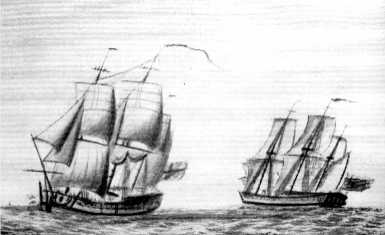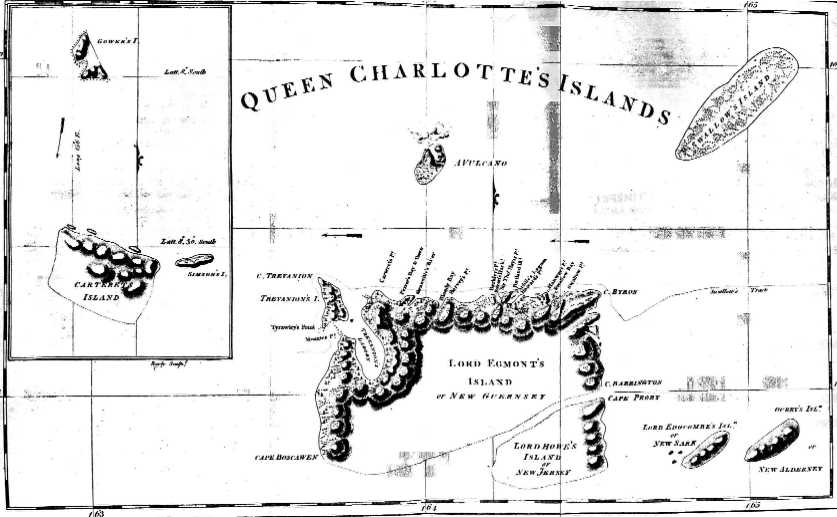|
|
|
Philippe de Carteret RN
(1733-1796)
Philippe's second circumnavigation 1766-69

Within weeks of de Carteret's return, a new expedition was planned which would be led by Captain Samuel Wallis in the Dolphin. De Carteret was given command of the Swallow, a 278-ton sloop with sixteen guns and a crew of one hundred and twenty five men. De Carteret now had the courtesy title of master and commander and was referred to as "captain". He was not enthusiastic about his new command,
" She was an old ship, having been in service thirty years and was in my opinion by no means fit for such a long voyage."In fact, Swallow had been used as a receiving ship on the Thames for new recruits and had never been employed on a long voyage. In August 1766, with de Carteret having spent less than three months in Britain, the Dolphin and the Swallow along with a supply ship the Prince Frederick set sail from Plymouth. It was not until September that Wallis informed de Carteret that the orders stated that he was to sail the Swallow round the world. By December 1766 they had reached the Straits of Magellan where he wrote a long account of the Patagonians who he described as being very large in stature. This paper was published by the Royal Society. By this time, the Swallow had proved herself to be very unresponsive and even after having her rudder enlarged she could not make her tack without having a boat to pull her round. De Carteret advised Wallis that it would be better if he transferred to the Dolphin and that the Swallow should return home bearing the expedition's sick and weak but Wallis refused. Finally after, after four months of struggling both ships approached the western end of the Straits and the Pacific Ocean was in sight. Here, Dolphin forged ahead and within twenty-four hours was out of sight of the Swallow. De Carteret maintained that he had been abandoned, whereas Wallis claimed that the weather had forced him to go on while the Swallow was sucked back into the Straits of Magellan by the cross currents. It has been claimed that Wallis was indeed wary of de Carteret’s success and regarded him as a threat. Fortunately, Wallis had given de Carteret a copy of his secret orders in case they did become separated. Alone and in an old unresponsive ship, largely crewed by sick men de Carteret faced the daunting task of discovering and charting new countries.

He sailed on a more southerly course than any previous mariner had taken and on 2nd July 1767 discovered Pitcairn Island, which he named after the midshipman who first spied this rocky outcrop. They continued west and reached the edge of the Paumotu Archipelago where they stopped at Osnaburg Island, named after one of the King’s sons. Continuing on their course they discovered a group of islands which de Carteret named the Duke of Gloucester Group. By the 10th August the Swallow was leaking badly, something that was to be a continual problem throughout he expedition, and the pumps had to be manned both day and night in order to keep her from sinking. On 12th August they anchored off Egmont Island (now Santa Cruz) in the Queen Charlotte Group. Many of the crew were suffering from scurvy and the vessel was leaking badly. De Carteret sent Simpson, the master of the vessel, to explore the island but he upset the natives by cutting down a palm tree which they considered sacred and the resulting attack left him and seven other crew severely injured. Simpson and three others subsequently died from their injuries. In the meantime the ship was repaired although they were unable to replenish their water supply and four of the islands were named Jersey, Guernsey, Alderney and Sark.
By 29th August they arrived at New Britain which had been discovered and named by Dampier a notorious buccaneer in 1710. De Carteret discovered that it was not one island, but in fact two separated by a channel which he called the St George’s Channel. He named the island to the north-east New Ireland. The crew were finally given a week's rest and most of them recovered to full health. They continued sailing west and discovered several new islands including New Hanover. De Carteret named the strait, which separated New Hanover from New Ireland, after his old Commander and so it was known as the Byron Strait. On 13th September they discovered Portland Island, on the 15th Admiralty Island, followed by Durour’s Island on the 19th, Maty’s Island on the 20th and Stephen’s Island on the 24th. On 25th September they encountered an island where the natives were very friendly. The chief of the island was given the name Joseph Freewill, and as a mark of gratitude for their friendship de Carteret named the island Freewill Island. Chief Joseph liked the ship so much, he joined the crew and continued on the expedition.
Continuing on a westerly course they passed a treacherous passage that became known as Carteret’s Reef and eventually reached the southern most tip of the Philippines, where the attitude of the natives made it impossible to land. Unable to replenish their stores with fresh food many of the crew once again were disabled by scurvy. However, they were able to rally themselves when they were attacked by a pirate ship and they managed to sink her. They then sailed to Macassor in the Dutch Indies where they arrived in December 1767; the ship was in a terrible state and many of the crew ill. De Carteret requested permission to come ashore and take on stores and make much needed repairs to his ship. However, the Dutch Governor refused him on the grounds that no foreign ship was allowed to enter the port. After many heated letters de Carteret was allowed to sail to the Bay of Bonthian, where he was able to get supplies. When he was informed by a "friend" of a plot to attack him, he threatened to run his ship aground and to use his guns to defend his ship and crew. The Dutch authorities denied any knowledge of such a plot and eventually De Carteret sailed to Batavia where he was able to make proper repairs to his ship. On the 15th September they sailed from Batavia and rounded the Cape of Good Hope on the 28th November. De Carteret eventually arrived back in England in March 1769, ten months after the Dolphin.
After the voyage
De Carteret received very little official acclaim for all his discoveries and on 12th January 1770 he returned to Trinity Manor to recover from the effects of his ordeal. In 1771 he was promoted to captain and in 1774 to post-captain, meaning that promotion was now simply a matter of course. He was recalled into active service during the American War of Independence commanding the frigate Druid in 1777 and then the Endymion in 1779. n 1780 with reports of an intended invasion of Jersey by the French he moved his family to Southampton, where they remained. In 1781 he successfully brought a convoy back to England from Jamaica. In 1794 his health failed and he retired from active service as Rear Admiral. On 21st July 1796 he died in Southampton and was buried in the catacombs of the Cathedral.
Click here to return to
de Carteret's first circumnavigation 1764-66Click here to return to
Phillipe de CarteretClick here to return to
Patrimoine